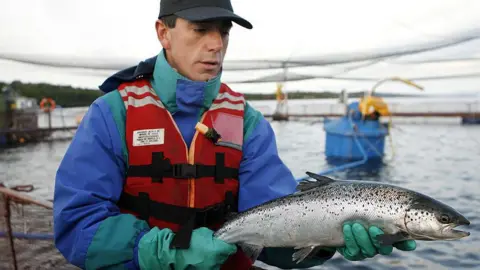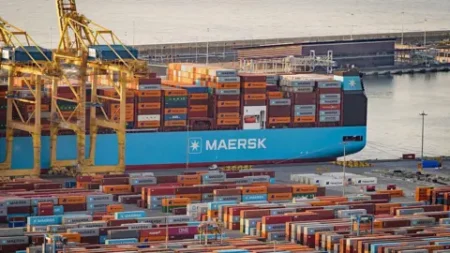**Chile’s Salmon Farms Hope for Calmer Waters**
In recent developments regarding Chile’s salmon farming industry, the country finds itself navigating both public and environmental scrutiny while attempting to assert its status as a leading global supplier of farmed salmon. Mexico ranks as the world’s second-largest exporter of farmed salmon, predominantly exporting to the United States. However, challenges persist due to conflicts surrounding the location of these farms, particularly in areas designated as protected environments.
At the epicenter of this burgeoning industry is the port city of Puerto Montt, located more than 1,000 kilometers south of Santiago, Chile’s capital. Puerto Montt, with its picturesque surroundings, serves as the heart of the Atlantic salmon farming sector, where facilities like those owned by Multi X are engaged in the preparation of fresh and smoked salmon for international markets, including the US and Japan.
Inside one of the processing plants, Francisco Lobos, the Chief Corporate Officer at Multi X, highlighted the transformative impact of salmon farming on the region. Lobos remarked, “Salmon’s been part of this region’s industrial revolution,” underscoring the economic upliftment that has occurred since the industry began flourishing. Many workers now earn higher wages compared to other parts of Chile, spurring a wealth of support services and attracting individuals from various areas seeking employment opportunities.
The roots of Chile’s salmon industry can be traced back to the end of the 19th century, when eggs were imported from the UK to promote recreational fishing. While netted offshore farming commenced in the 1970s, the sector has seen exponential growth, with over 1,300 active salmon farms reported by the end of last year. By 2024, Chile exported approximately 782,000 tonnes of salmon and trout, with a market value reaching $6.4 billion, making salmon the country’s third-largest export after copper and fresh fruit.
The industry employs around 86,000 individuals directly and indirectly, underscoring the vital role of salmon farming in the Chilean economy. The farming operations stretch from the Biobío region, around 500 kilometers south of the capital, to the Magallanes region in the far south of Patagonia, emphasizing the industry’s expansive footprint across the southern coast. Nevertheless, global demand for farmed salmon is anticipated to increase significantly, which puts pressure on producers to enhance their output even though production has dipped slightly in recent years.
Industry leaders, including Arturo Clements, Chair of Salmón Chile, have urged the government to simplify regulations and facilitate long-term strategies for growth. Clements indicated that existing complexities and conflicts over maritime use hinder growth opportunities within the industry.
Environmental concerns surrounding salmon farming, particularly those relating to pollution, have fueled debates within the industry. Critically, many farming concessions are located within areas that are supposedly protected. Of the 408 concessions granted by the government, over half are situated in national reserves, which allow limited commercial use of resources, while 29 are located in national parks where commercial activities should be prohibited.
Flavia Liberona, Executive Director of the environmental advocacy group Terram, supports the campaign “Save Patagonia,” aiming to halt salmon farming in national parks. Liberona articulated the adverse environmental effects attributed to farming, notably how the fish are raised in cages and fed pellets, which contribute to pollution. The accumulation of food waste and fish excrement beneath the cages diminishes oxygen levels, impacting marine life substantially.
Clement addressed these environmental concerns, asserting that many concessions in national parks are not operational and expressing a desire for relocation, which has faced bureaucratic delays. The Undersecretariat for Fisheries and Aquaculture regulates the industry, ensuring environmental protections while working towards a new aquaculture law that could impose stricter regulations.
Julio Salas Gutiérrez, the Undersecretary of Fisheries and Aquaculture, emphasized government efforts to move fish farms from environmentally sensitive national parks. He acknowledged the complexities involved in relocation, which often requires significant time and coordination with various stakeholders.
In the end, while the Chilean salmon farms are positioned for growth amid rising global demand, the road ahead remains complex, with environmental activists and government regulators at odds over the future sustainability of salmon farming in the region. The balance between economic gain and environmental preservation will be critical in shaping the industry’s future, especially as Chile approaches another pivotal electoral period where policies on aquaculture may continue to evolve.











